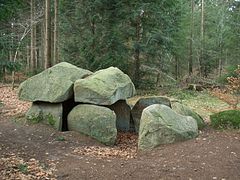Great stone graves near Steinfeld (Bülstedt)
| Large stone graves near Steinfeld | ||
|---|---|---|
|
Great stone grave Steinfeld 1 |
||
|
|
||
| Coordinates | 53 ° 13 '12.8 " N , 9 ° 12' 46.5" E | |
| place | Bülstedt , Lower Saxony , Germany | |
| Emergence | 3500 to 2800 BC Chr. | |
| Sprockhoff no. | 649-650 | |
The large stone graves near Steinfeld keep several graves of unknown numbers near Steinfeld , a district of the municipality Bülstedt in the district of Rotenburg (Wümme) in Lower Saxony . They come from the middle Neolithic (3500–2800 BC) and are megalithic systems of the funnel beaker culture (TBK). Today only two graves remain. They bear the Sprockhoff numbers 649 and 650. Several other graves, which, according to Martin Mushard, were located between Steinfeld and Wilstedt , were destroyed in the 18th or 19th century.
location
The first system with the Sprockhoff no. 649 is located northeast of Steinfeld in a group of trees on the eastern edge of state road 132. The second grave is in Steinfelder Holz east of the village and about 950 m south of grave 1. 2.6 km southeast of grave 2 is the large stone grave Nartum .
description
Grave 1
The complex used to have a round hill (rare in this region), of which 17 stones are still around the burial chamber . Of these, only the most southwestern one is in situ . The chamber is well preserved and can be seen as a passage grave. It is oriented northeast-southwest and has a length of 5.2 m and a width of 1.9 m. It consists of four pairs of wall stones on the long sides and one end stone each on the narrow sides. These are all still in situ. Ernst Sprockhoff was unable to find the westernmost stone on the north-western long side when he was photographed in 1930; but it is also there and was put back in its original position during a later restoration. The gaps between the wall stones and between the surrounding stones were filled with dry stone slab masonry that was restored during the restoration. Sprockhoff could still find four capstones. Of these, two still lay on the wall stones, and two more had fallen into the chamber. Today there are only three capstones left: two are on the wall stones, one right next to the chamber. In the past five stones could have covered the chamber. A narrow gap in the middle of the south-eastern long side allowed access to the chamber. Two of the original four wall stones of the upstream corridor are still preserved.
Grave 2
The complex has a north-south oriented burial chamber, which is probably a passage grave. The chamber was originally well overhanged and consisted of three pairs of wall stones on the long sides, one end stone each on the narrow sides and three cap stones. When Sprockhoff took the picture, the southern end stone, the two adjacent wall stones on the long sides, the middle wall stone on the east side, the north wall stone on the west side, the northern end stone and the southern and middle cap stone were present. The southern capstone was still on the wall stones, the middle one had fallen into the interior of the chamber on one side. The northern wall stone on the east side, the middle one on the west side and the northern capstone were missing. Sprockhoff interpreted the gap on the west side as an entrance to the chamber. During a later restoration, the two missing wall stones were added, leaving a gap between the middle and northern stone on the east side. Contrary to Sprockhoff's assumption, this was probably where the actual access was located. It is unknown whether the missing stones by Sprockhoff were simply overlooked or added during the restoration. The middle capstone was put back on the wall stones during the restoration. A stone north of the chamber could be a fragment of the missing northern capstone.
Trivia
Martin Mushard (1699-1770) tells of the Otterberger magistrate Justus Kelp (1650-1720), who was a "Monumentum to Stenfeld ... by, a number of people undermined". According to his own statement, the excavation attempt did not get him: “During the night three men appeared to him who spoke an unknown language to each other and one of whom was one-eyed. With a menacing look they finally indicated to him: 'You would have died as heroes for your fatherland, he would pursue you to worry, should he go there neither star nor luck'. "Kelp was a scholar and collector whose traces can be seen throughout history the land around Bremen takes place.
See also
literature
- Wilhelm Blasius : Megalithic grave monuments of north-western Germany. In: 10th annual report of the Association for Natural Science in Braunschweig. 1897, p. 279 ( online ).
- Hery A. Lauer : Archaeological walks in northern Lower Saxony. A guide to sights of prehistory and early history. Volume II. Verlag H. Lauer, Angerstein 1979, p. 150.
- Johannes Heinrich Müller , Jacobus Reimers : Pre and early historical antiquities of the province of Hanover. Schulze, Hannover 1893, p. 226 ( PDF; 25.0 MB ).
- Ernst Sprockhoff : Atlas of the megalithic tombs of Germany. Part 3: Lower Saxony - Westphalia. Rudolf-Habelt Verlag, Bonn 1975, ISBN 3-7749-1326-9 , pp. 18-19, 20.
- Johann Karl Wächter : Statistics of the pagan monuments existing in the kingdom of Hanover. Historical Association for Lower Saxony, Hanover 1841, p. 54 ( online ).







